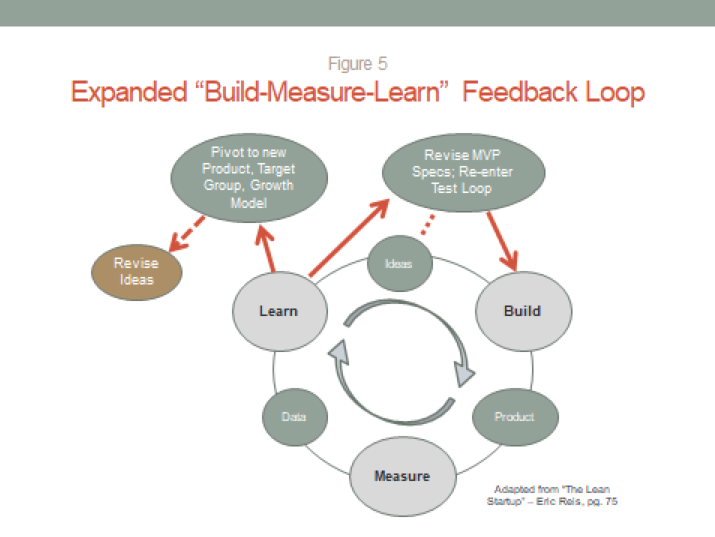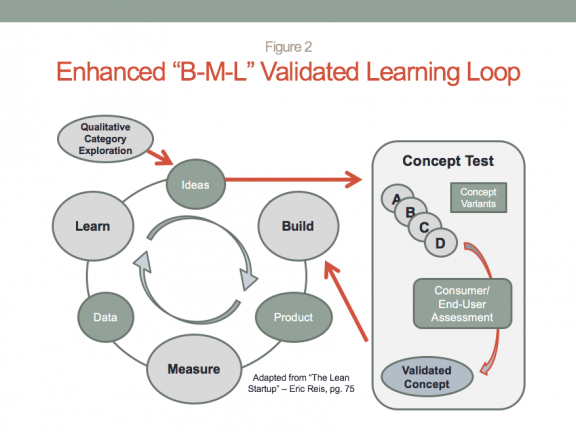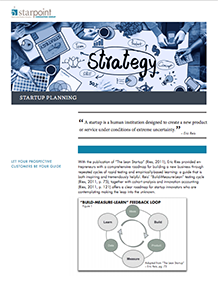IMPROVING BUILD-MEASURE-LEARN
THE VALIDATED LEARNING FEEDBACK LOOP
Expanding “Build-Measure-Learn” As presented in “The Lean Startup, ”Reis’ “Build-Measure-Learn” feedback loop looks like the diagram presented in Figure 1 (Ries, 2011, p. 75); it has been modified here in Figure 5 to show the implied, but not diagrammed, additional steps.

The lead element in the original feedback loop is “Ideas”: the vision, the inspiration, the dream that stands behind the development effort. But the core element of the “Build-Measure-Learn” feedback loop is the “minimum viable product” (MVP): a stripped-down, but testable, version of the envisioned product that can be presented to prospective customers to test core assumptions regarding target customer responses and revenue growth potential. The MVP is the result of the “Build” phase of the feedback loop and it is the focus of the testing cycle. Ries specifies that the MVP should be constructed to permit a full turn of the “Build-Measure-Learn” loop with the testing cycle accelerating as the MVP is progressively refined – or the decision is made to “pivot” to another approach. (Insert Fig 5 around here somewhere)
THE BIG PICTURE
Enhancing the Validated Learning Loop. Let’s demonstrate how the “Build-Measure-Learn” feedback loop can be modified to incorporate prospective customer and/or end-user feedback. Both of the recommended additional steps come at the front-end of the validated learning cycle where the impact can be the greatest: prior to any investment in the “Build” phase of the process.

The qualitative category exploration is designed to inform and to clarify the entrepreneur’s vision of the market and of the proposed new product or service – specifically, how the startup might best fit within the framework of existing options. This, in turn, leads to the concept test phase where those ideas are translated into specific product descriptions complete with references to unique features and a clear, compelling customer benefit.
By injecting customer research into the front-end of the process, the objective is to dramatically reduce uncertainty in terms of feature set, user benefit and product positioning, which form the conceptual framework for the MVP. This, in turn, should both focus and accelerate the “Build-Measure-Learn” feedback loop by eliminating non-starters before the “Build” process is initiated.
Talk to customers first, not last! At one point in Reis’ continuing saga of “things gone wrong” he makes the following, rather startling, admission:
“When I could think of nothing else to do, I was finally ready to turn to the last resort: talking to customers. Armed with our failure to make progress tuning our engine of growth, I was ready to ask the right questions.” (Ries, 2011, p. 124)
Why wait until you’re at the point of failure before talking with your customers? For anyone coming from marketing background, that just sounds like either arrogance or lack of experience. There are three clear and compelling benefits to talking with prospective customers at the earliest stages in the startup development process.
- To understand the category from the customer’s perspective – thereby quickly dispensing with invalid assumptions that lead down blind alleys at the outset of a project.
- To quickly isolate the crucial features and essential functionality that prospective uses demand, and to dispense with those they see as secondary or completely unnecessary – thereby creating a blueprint for the MVP and the initial build stage.
- To identify the most compelling customer benefit and supporting product features (“reasons to believe”) that will constitute the positioning platform for the product’s roll-out. These are crucial elements for developing a marketing campaign that can effectively generate informed customer awareness and product demand.
In summary, talking to your prospective customers early in the process can dramatically reduce the uncertainty surrounding the initial stages of any startup activity. A/B testing and rapid turns of the validated learning loop are great for improving existing features, for prioritizing new features and for enhancing the user interface – once a validated product concept exists. But at the earliest phases, when it’s all just an entrepreneurial “Idea”, a small investment in upfront customer research will do a lot more to reduce “extreme uncertainty” than will coding hunches and running in circles.
For the complete story,
download the PDF
Works Cited
Moore, G. A. (2014). Crossing the Chasm: Marketing and Selling Disruptive Products to Mainstream Customers (3rd Edition ed.). New York: HarperBusiness, and imprint of HarperCollins Publishers.
Ries, E. (2011). The Lean Startup: How Today’s Entrepreneurs Use Continuous Innovation to Create Radially Successful Businesses. New York: Crown Publishing Group, a division of Random House, Inc.
Please contact us for additional information.



